
Key takeaways
- Slim4 by Slimstock is a supply chain platform designed for large organisations. It offers detailed forecasting options but can be complex to implement for fast-moving e-commerce businesses.
- In this article, we compare Optiply, Netstock, Inventory Planner (by Sage), SAP Integrated Business Planning, and Anaplan as alternatives to Slim4.
- Optiply stands out for their 100% automated purchasing and forecasting, helping e-commerce, retail and wholesale businesses that purchase daily to prevent stockouts and optimise their cash flow.
What is Slim4 and why do e-commerce businesses work with them?
Slim4 is the inventory optimisation software developed by Slimstock. They are known for helping large organisations manage complex supply chains. Slim4 offers forecasting models, ABC classifications and safety stock calculations to plan inventory more efficiently.
Many businesses work with Slim4 because of their reliable forecasting, especially if they have dedicated supply chain teams in place. For businesses that purchase daily, Slim4 can feel too manual and rigid. Implementation takes a relatively long time, it requires ongoing training, and reacting to demand changes or seasonal peaks still involves manual work instead of automation.
Because of these downsides, many companies start exploring other options that offer more flexibility, faster implementation, and automation. To help you make the best decision, let’s look at the best 5 Slim4 alternatives to consider.
A side-by-side comparison of Slim4 competitors
Short on time? Here’s a quick overview of the top 5 Slim4 alternatives and what they’re best for:
Below, we take a closer look at each solution to help you understand which fits your business best.
Comparison: the 5 best Slim4 alternatives
Every solution has its strengths and limitations. Below, we compare how they work, what key features they offer, and which type of business they’re best suited for.
1. Optiply
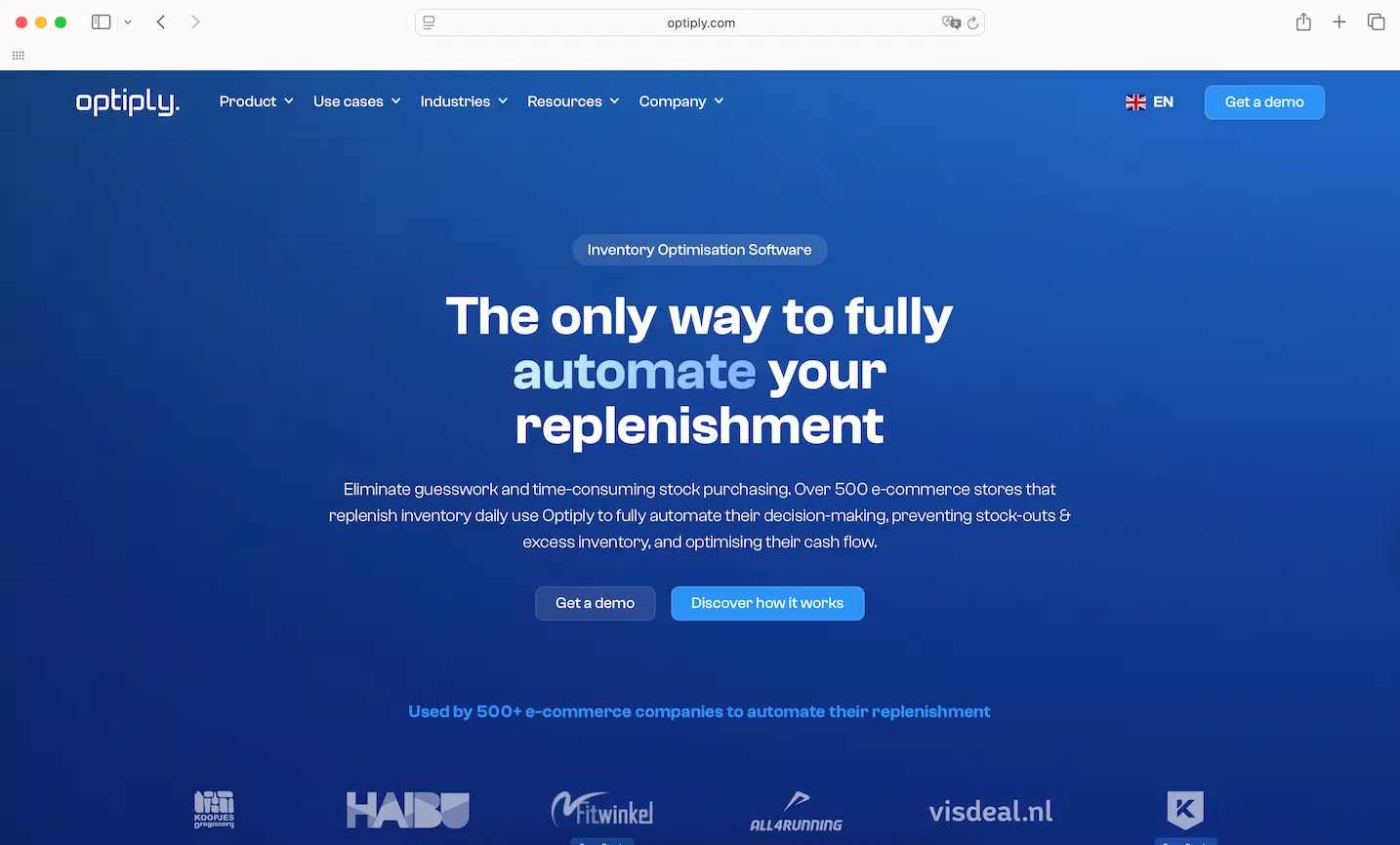
That’s us! Optiply is an AI-powered inventory optimisation platform designed for e-commerce, retail, and wholesale businesses that purchase daily and manage large assortments. Optiply fully automates the replenishment process, from demand forecasting to creating and sending purchase orders to suppliers.
What sets Optiply apart is its focus on automation. The platform was founded by former e-commerce entrepreneurs who experienced how difficult it was to keep stock balanced using spreadsheets. Every change in demand, supplier delay, or seasonal peak adds complexity that is nearly impossible to manage manually.
Optiply continuously analyses real-time data such as delivery reliability, lead times, and external factors like seasonality. The results are smarter purchasing decisions that are made automatically.
By reducing manual work and errors, and no need for lengthy training or consultancy, teams can keep stock levels balanced and focus on what matters most. Growth!
Website: www.optiply.com
Best for: Automating purchasing decisions and forecasting for e-commerce, retail, and wholesale businesses that buy daily.
Key features:
- Uses AI-driven forecasting that combines multiple models and learns from new data every day. It analyses sales data, seasonality, accurate delivery times, and more.
- Automatically forwards purchasing recommendations to the right suppliers via EDI, portal, or email. This turns your purchasing process from manual to fully automated.
- Optiply’s dynamic purchasing calendar automatically adjusts order timing and size based on demand shifts, supplier lead times, or seasonality.
- Applies ABC-XYZ product categorisation to help you focus on the products that matter most. The ABC analysis ranks items by revenue or margin, while the XYZ analysis looks at demand predictability. Together, they ensure you maintain high availability for key products without overstocking.
- Automatically matches each product with the best supplier based on price, lead time, and delivery reliability, preventing stock-outs while minimising purchasing costs.
Tygo Bril, Purchaser and Process Improvement Specialist at Travelbags highlights how working with Optiply has made the procurement process more efficient:
“By relying more on Optiply, our procurement process is much more efficient and effective. Where we used to check and update orders manually, we can now arrange everything for reorders of our bestsellers with just a few clicks.”
2. Netstock
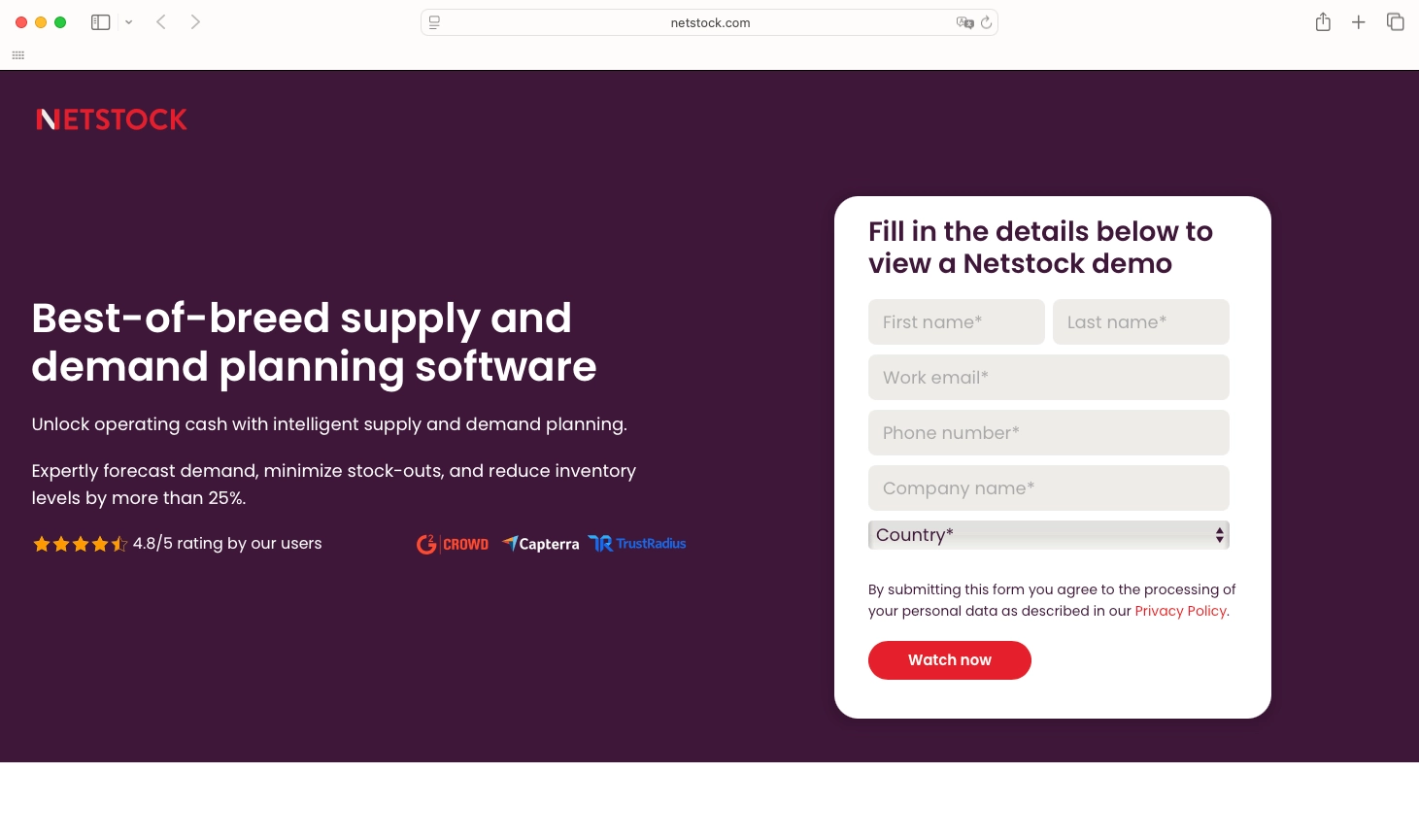
Netstock is a supply and demand planning platform that helps businesses reduce inventory levels and save time on ordering and demand planning. It automatically integrates ERP data into its system, giving teams easy access to stock insights and purchasing recommendations.
The platform is designed to work within ERP environments. As it doesn’t connect to WMS or e-commerce platforms, it may limit real-time insights for e-commerce businesses or retailers.
Website: www.netstock.com
Best for: Best for mid-sized companies using ERP systems that want to keep hands-on control over their inventory planning.
Key features:
- Demand forecasting based on historical data
- Strong integration with ERPs
- Supplier performance tracking
- Inventory classification and prioritisation
- Automated reorder suggestions
What users say about Netstock: What users appreciate about Netstock is that it helps improve inventory levels and fill rates, and once you’re comfortable with the basics, there are additional features you can explore to further benefit your business.
3. Inventory Planner (by Sage)
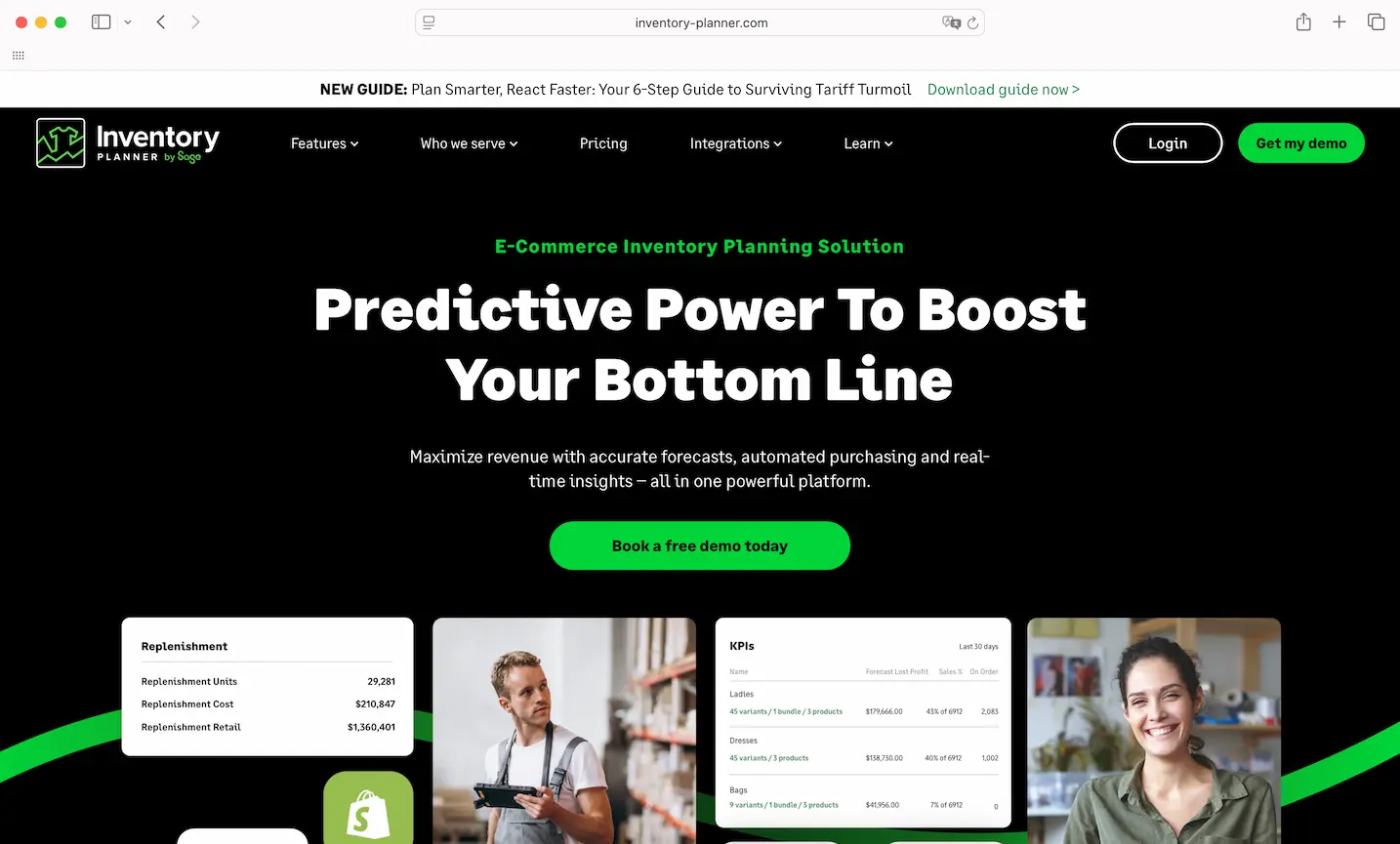
Inventory Planner (by Sage) is an e-commerce inventory planning system built for smaller e-commerce businesses. It helps them to predict demand, optimize stock and free up cash, reducing the risk of stockouts and excess inventory.
Acquired by Sage, Inventory Planner is part of a broader finance and operations suite, giving smaller retailers an accessible way to manage their inventory planning. The simple setup makes it easy to handle forecasting and replenishment manually. As product ranges and order volumes expand, this manual approach can become time-consuming and limit scalability.
Website: www.inventory-planner.com
Best for: Best for small e-commerce and retail businesses that sell across multiple channels and want straightforward forecasting and replenishment.
Key features:
- Forecasting based on historical sales trends
- Automated buying recommendations
- Seasonality adjustments
- Integration with e-commerce platforms
- Bundling and kit forecasting
What users say about Inventory Planner (by Sage): What users appreciate about Inventory Planner is that it performs well when sales are consistent and the data algorithm is generally reliable. However, it can struggle with unusual sales patterns, making it challenging to always determine the exact reorder quantity.
4. SAP Integrated Business Planning
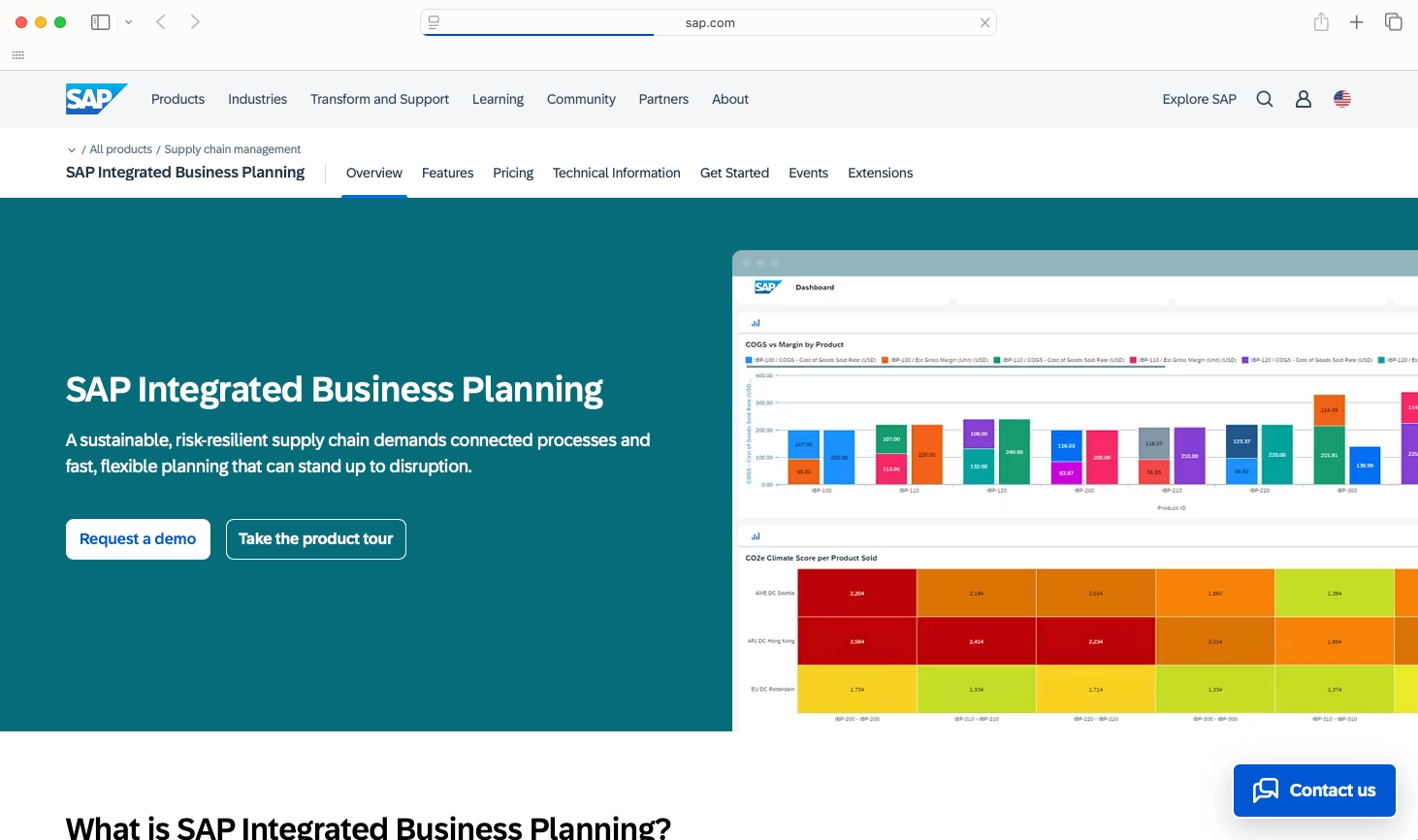
SAP Integrated Business Planning (IBP) is a planning platform designed for global supply chains. It combines demand, supply, and inventory planning in one cloud-based system to help large businesses align sales, operations, and finance. With features like scenario modelling, real-time alerts, and smart forecasting, it helps large organisations respond faster to changes in demand and supply.
While SAP IBP is powerful, it’s also complex. It’s primarily built for large enterprises that have an existing SAP infrastructure with other SAP systems. The platform works best for organisations with the time, budget, and in-house expertise to manage it effectively.
Website: www.sap.com/products/scm/integrated-business-planning.html
Best for: Best for large international businesses that want to centralise demand, supply, and inventory planning across departments, with the resources to manage a complex system.
Key features:
- Demand, supply, and inventory planning in one environment
- Scenario and simulation capabilities
- Collaboration across departments (sales, operations, finance)
- Machine learning-based forecasting
- Integration with SAP-tools
What users say about SAP Integrated Business Planning: What users appreciate about SAP Integrated Business Planning is how effectively it unifies and simplifies planning processes across departments. While it’s a powerful tool for business planning, many users find its complexity and steep learning curve to be significant challenges.
5. Anaplan
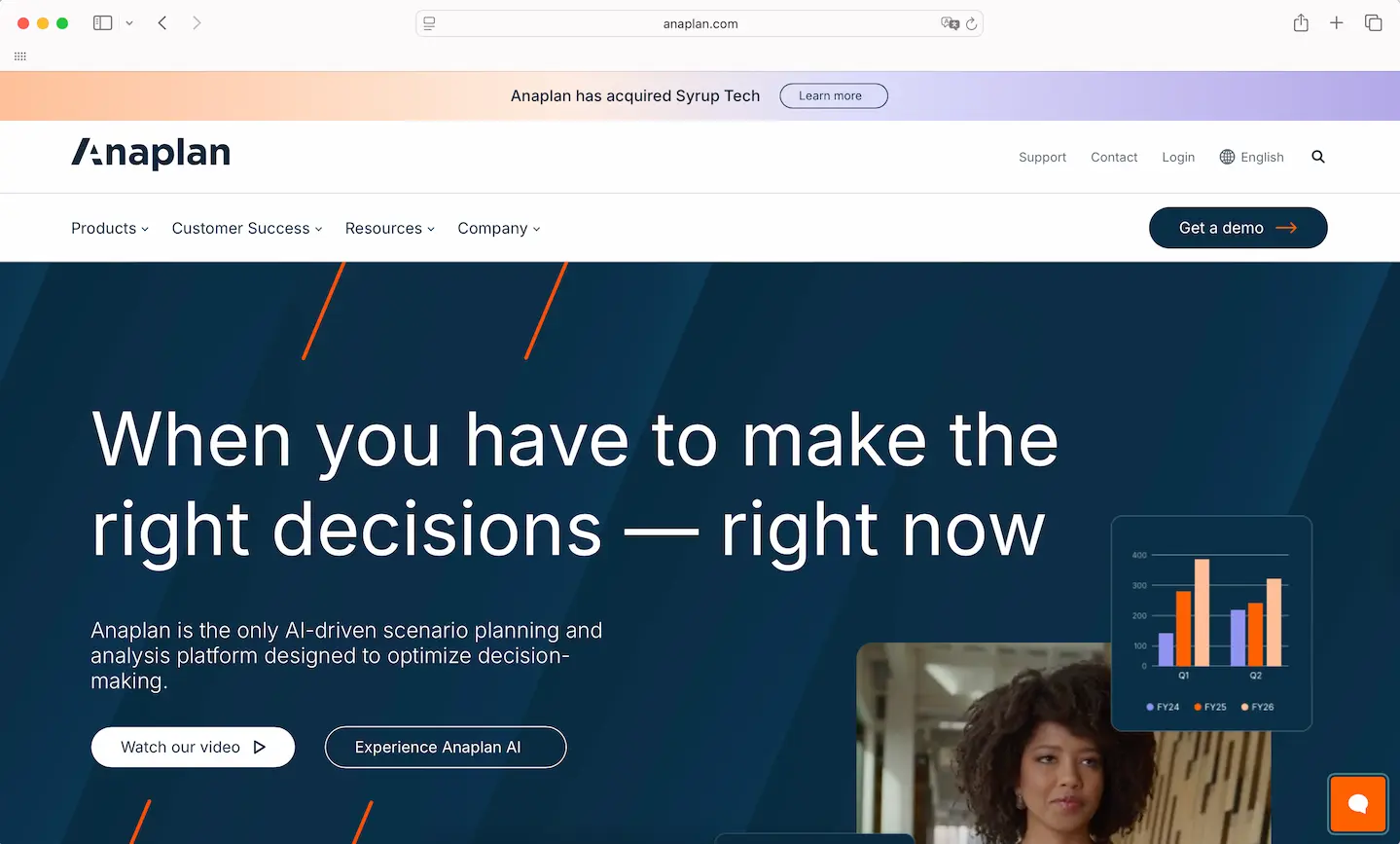
Anaplan offers a demand planning application that helps large organisations forecast demand and align sales, operations, and finance teams. It is designed to improve forecast accuracy and collaboration across departments.
Anaplan does not automate replenishment or purchasing. The platform focuses on strategic planning rather than day-to-day inventory optimisation, making it less suitable for businesses that purchase daily.
Website: www.anaplan.com
Best for: Best for large organisations managing planning across finance, operations, and supply chain, with a focus on collaboration and scalability.
Key features:
- Demand forecasting and scenario planning
- Real-time data sharing and collaboration across teams
- Consensus forecasting to align departments
- Scalable, cloud-based planning environment
What users say about Anaplan: What users appreciate about Anaplan is that solutions can be implemented in as little as one week by business users with technical know-how. However, the lack of a single standardized approach can lead to inconsistent model building.
How do you choose the best inventory optimisation software for your organisation
Choosing the right solution for your business depends on what your business needs. Below are five criteria to consider when evaluating inventory optimisation software or Slim4 alternatives.
Automation of inventory processes
The best tools don’t just provide you with insight, they automate actions. Look for a solution that translates forecasts into purchasing recommendations or even direct orders. This way, your team spends less time on manually checking data and more time on strategic work.
Real-time response to change
Your demand and supply conditions can shift daily. Choose a system that updates forecasts automatically and reacts to new data, such as sudden demand changes of supplier delays, without having to adjust this manually.
Alignment with your purchasing cadence
Not every business purchases on a weekly or monthly basis. If you buy daily, you need a system that automatically adjusts order timing and quantities. This way, it keeps inventory levels healthy and operations running efficiently.
Integration with your existing tech stack
Inventory optimisation doesn’t happen in isolation. Make sure the software you’re choosing connects with your ERP, WMS, and e-commerce systems, so decisions are based on complete, up-to-date information from across your business.
Scalability without added complexity
As your assortment grows, the system you use should grow with you. The right solution stays simple to manage, even as order volumes and product ranges expand. Look for a tool that automates key tasks, so you can scale without adding extra complexity or manual work.
Ready to see how automation can simplify your purchasing process?
Most frequently asked questions about Slim4 alternatives
How long does it take to implement inventory optimisation software?
Implementation time depends on the complexity of the system you’re choosing. Solutions like SAP IBP and Slim4 can require weeks of training and implementation, while other tools can be connected and running within days. Choose a solution that fits your business size and internal capacity.
Can inventory optimisation software fully automate my purchasing process?
Yes, the most advanced platforms use AI and multiple forecasting models to automate forecasting and purchasing decisions. These systems look at data from sales, ABC categorisation, seasons, trends, peaks, and actual delivery times, and translate this into orders automatically.
What improvement in inventory management efficiency can I expect from switching to other solutions?
Moving from manual or rule-based methods to modern inventory optimisation software typically improves efficiency by 20-30%. Switching from semi-automated tools to a fully automated system can deliver another 20-30% improvement. This means a total efficiency improvement of up to 60% comparing Optiply vs. traditional inventory optimisation software.
Will I still need a buyer if everything runs automatically?
Yes, but it is likely that their role changes. Instead of spending time on manual calculations or order tracking, buyers can focus on analysing exceptions, supplier negotiations and building relationships. Automation doesn’t replace buyers, it helps them.
Why Optiply is the best software solution for e-commerce businesses that purchase daily
Choosing the right inventory optimisation software is important for any growing business. Solutions like Slim4, Netstock, Inventory Planner (by Sage), SAP Integrated Business Planning, and Anaplan offer solid options. But for e-commerce, retail, and wholesale businesses that purchase daily, speed and automation make all the difference.
That’s where Optiply comes in. Optiply uses AI and multiple forecasting models to fully automate forecasting and replenishment decisions. This way, your team moves away from manual spreadsheets and guesswork.
With Optiply you:
- Automate purchasing decisions based on all your real-time data
- Buy proactively based on trends and seasonal demand shifts
- Prevent stock-outs and excess inventory and keep control over your cashflow
- Increase revenue by ordering at the right time and with the right supplier
Over 500 e-commerce, retail and wholesale businesses rely on Optiply, automating their purchasing decisions and keeping their business running smoothly.
Do you want to see how Optiply works? Book a free demo and discover the difference Optiply can make.
Answers to frequently asked questions
Do you have questions about Optiply? We've gathered the most frequently asked questions for you.













.webp)
.webp)